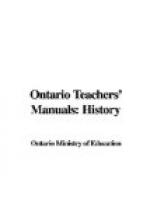STEP IV
The Feudal System under William: (Note the innovations of William.)
1. The land belonged solely to the king; it was not the Normans as a tribe, but William personally, who conquered England.
2. The estates of the nobles were divided, either deliberately or because the land was conquered piecemeal and parcelled out as it was conquered. (For example, Odo had 473 manors in 17 counties.)
3. The vassals swore direct allegiance to the king.
4. The Witan was displaced by the Great Council, the members of which were the king’s vassals; therefore with him, not against him.
5. The king’s use of shire-reeves, personal dependants, who led the military levy of the counties and collected the king’s taxes.
6. What were the chief taxes? From them came much political trouble in later times by attempts to rectify abuses in connection with them.
7. The teacher may describe the ceremony of the feudal oath.
The important points of each step should be written on the black-board as they are described or developed.
(The decay of the Feudal System in England may be the topic of another lesson.)
SEIGNIORIAL TENURE
The aim of the lesson is to give the pupils a knowledge of the method of land tenure introduced into Canada by the French; to enable them to trace the effects of this system upon the progress of the people and the development of the country; and to increase their interest in the present system of tenure.
METHOD
In connection with sections 3 and 4 the description of the Feudal System would show how the land was held in France; first by the king, under him by the greater nobles, then by the lesser nobles and the gentry, then by the large farmers who sublet it in small farms or hired men to work it. Every one who held land had to do something for his lord. When this description is complete, let the pupils apply it to Canada, the teacher supplying the names of the corresponding classes in Canada. Then the pupils may be asked to consider what return each holder would make for his land; this leads to a statement of the conditions of tenure in Canada. Then the evils connected with this system may be presented as another problem; for example, how would the actual workers be discouraged in making improvements that they would get no credit for? In connection with section 5, the pupils can contrast the method of holding land that they are familiar with, that is, by complete ownership, and can imagine what changes the English settlers would want. They are then ready to hear how and when these changes were brought about, and at what cost.
The method is therefore a combination of the narrative and development, or problem, methods.




